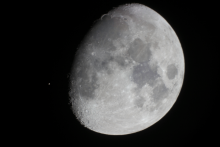Listen to today's episode of StarDate on the web the same day it airs in high-quality streaming audio without any extra ads or announcements. Choose a $8 one-month pass, or listen every day for a year for just $30.
You are here
Moon and Aldebaran
Carbon is the second-most-abundant element in the human body. In fact, it’s the element that makes life on Earth possible. And every single atom of it was produced in the heart of a dying star.
For most of its life, a star shines by “burning” the hydrogen in its core. It fuses the atoms together to make helium, releasing energy in the process.
As the star uses up the hydrogen, its core gets smaller and hotter. Eventually, the temperature reaches a couple of hundred million degrees Fahrenheit — several times the present-day temperature in the heart of the Sun. At that temperature, helium atoms fuse together to produce carbon.
As that happens, the star’s outer layers expand and cool, turning the star into a red giant. A conveyor-belt process dredges material from the core — including carbon. Powerful “winds” blow some of that material out into space.
Later, nuclear fusion in the core shuts down. The core collapses to form a white dwarf. And the star’s outer layers are expelled into space. Carbon and other elements in those layers fly out into the galaxy, where they can be incorporated into new stars, planets — and perhaps living organisms.
One star that will add to the carbon supply soon is Aldebaran, the eye of Taurus, the bull. The bright orange star rises just below the last-quarter Moon, after midnight. It’s already a red giant, and it’ll begin making carbon before long — a key ingredient for life as we know it.
Script by Damond Benningfield




